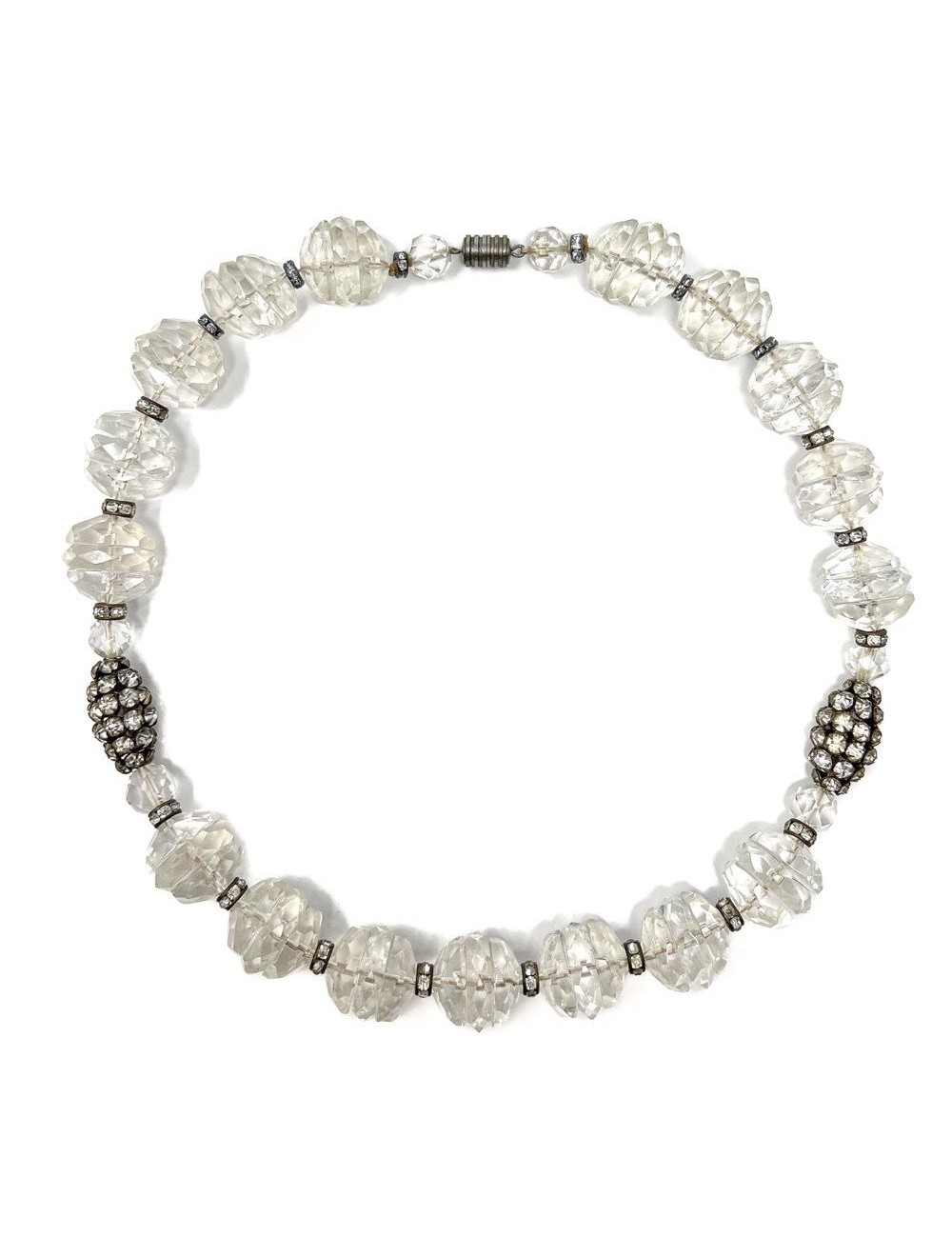- On sale!
- -25%






This lovely and wearable example of a glass bead Art Deco necklace was most likely created in France.
Condition Report:
Excellent
For more information about this necklace, read below...
The Details...
This necklace features small, round, colourless glass beads. The illusion of large colourless glass beads is created by having 2 semi-spherical beads positioned either side of a rondelle bead. The glass beads are interspersed with round, colourless paste stones set into metal rondelles. There are also two teardrop shaped metal beads covered entirely with small, round, colourless, claw set paste stones. The necklace measures 50cm in length. The necklace has a barrel clasp.
A Short History...
Glass has been a prevalent feature of costume pieces since the invention of jewellery. An easily accessible material that can be formed into any shape and dyed any colour. Glass was heavily used in 1920s and 1930s pieces, such as this necklace, because it could be dyed in a vast array of colours to meet the need for affordable jewellery after the Great Depression and First World War.
Wear it With...
This necklace looks classic and elegant paired with a deep black roll neck knit and grey wool trousers.
The jewellery within the Gemma Redmond Vintage collection has survived to this day because it has been well cared for throughout its lifetime. It is important to continue to care for the jewellery that you buy from us to ensure its continued preservation. Here are some suggestions:
- Be sure to store your jewellery within the boxes that we provide to ensure that it is protected. This is especially important when travelling with your pieces.
- Try not to get perfume or hairspray on your items. These liquids can damage the materials that our jewellery is made from.
- Try not to drop your jewellery or catch your jewellery against hard surfaces. If this happens over time, the findings and fixings can loosen and wear.
- Try not to get your jewellery wet. Some costume jewellery manufacturers utilised water soluble glue in the making of their pieces. Getting your jewellery wet could cause rhinestones and other details to fall away over time.
- If you wish to clean your jewellery, use a soft polishing cloth or a soft brush.
This beautiful pendant was created in the 1800s.
Condition Report:
Very Good - Some darkening in colour to the central paste stone. This is consistent with age and does not detract from the appeal of this rare piece.
For more information about this pendant, read below...
This stylish necklace was probably created in Austria or Germany in c.1900.
Condition Report:
Excellent
For more information about this brooch, read below...
This edgy 1980s necklace is an unsigned statement piece.
Condition Report:
Excellent
For more information about this necklace, read below...
This beautiful pendant was created in Italy in the early 1900s.
Condition Report:
Excellent
For more information about this bracelet, read below...
This unsigned necklace represents elegant 1930s design.
Condition Report:
Very Good - One of the joins in this hand-knotted necklace shows some signs of repair and there is some darkening to a couple of rhinestones consistent with age. These points are only visible upon very close inspection.
For more information about this necklace, read below...
This stylish necklace was made in the 1990s in France by the Inès de La Fressange brand.
Condition Report:
Excellent
For more information about this necklace, read below...
This wonderful example of 1960s statement jewellery is an unsigned, high quality beauty.
Condition Report:
Excellent
For more information about this necklace, read below...
This stylish necklace dates from the 1930s. It was most likely made in Czechoslovakia.
Condition Report:
Excellent - The catch and rhinestones are later replacements. However, they are in-keeping with the design of the piece.
For further information about this necklace, read below...
This beautiful portrait miniature pendant was created in France.
Condition Report:
Excellent
For more information about this piece, read below...
This pretty necklace dates from the 1950s and was most likely made in France or Italy.
Condition Report:
Excellent
For more information about this necklace, read below...
This pretty 1930s necklace is made from silver.
Condition Report:
Excellent
For more information about this necklace, read below...
This dramatic necklace was most likely created in the 1970s.
Condition Report:
Excellent
For more information about this necklace, read below...
This beautiful pendant necklace is a wonderful and rare example of Art Nouveau carved horn jewellery. It is unsigned.
Condition Report:
Excellent
For more information about this necklace, read below...
This chic necklace dates from the 1980s. It was sourced in France and was most liely created there too.
Condition Report:
Excellent
To learn more about this necklace, read below...
This beautiful necklace was created in Oslo, Norway, in the 1950s by jeweller, Arne Nordlie.
Condition Report:
Excellent
For more information about this necklace, read below...
This elegant long chain was created c.1900. It features an unusual combination of coloured glass and crystal.
Condition Report:
Very Good - One link is possibly a later replacement. This is only apparent upon very close inspection and does not detract from the appeal and rarity of the piece.
For more information about this necklace, read below...

This lovely and wearable example of a glass bead Art Deco necklace was most likely created in France.
Condition Report:
Excellent
For more information about this necklace, read below...